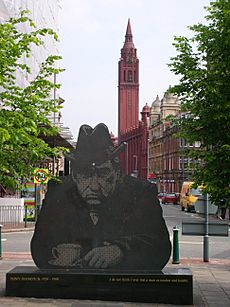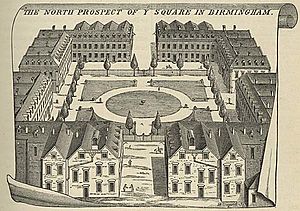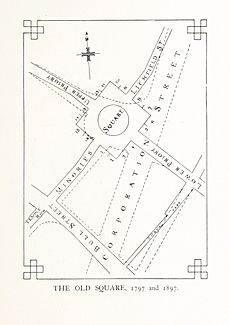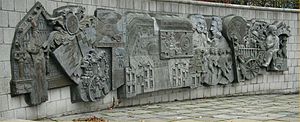Old Square, Birmingham facts for kids

Old Square is a well-known public space and road junction in the very heart of Birmingham City Centre, England. It has a long and interesting history, changing a lot over hundreds of years.
Contents
The Early Days of Old Square
Before the Square Existed
The area where Old Square is today was once home to a very old building called the Priory of St Thomas of Canterbury. A priory was like a monastery, a place where monks lived and worked. The roads nearby, like The Minories, Upper Priory, and Lower Priory, were the original paths leading to this priory. People believe this spot was one of the highest points in Birmingham city centre, which is why the priory was built there.
In 1536, the priory was closed down, and its buildings were taken apart in 1547. For about 150 years, the land remained mostly ruins.
Building the First Square
In 1697, a man named John Pemberton bought the land. He cleared it to create his "Priory estate." The square we know today started to take shape around 1713. It was designed to have 16 similar two-story houses. These houses had special features like angled pillars and fancy doorways.
William Westley designed the layout of the square. He even made a drawing of it in 1732. One house, called "the Angle House," became very popular. Its price kept going up over the years, showing how valuable property in the square became.
Changes to Old Square Over Time
The Square's Centre
The middle of Old Square used to be closed off with iron fences and had several paths for people to walk on. However, over time, this central area became a bit messy.
In 1832, the square was the site of a public gathering during a parliamentary election. During this event, stones from the square were thrown by the crowd. Because of this and other accidents, the trees and fences were removed between 1836 and 1837. The Birmingham Street Commissioners then made the roads wider, making the area safer.
Building Corporation Street
A big change came in 1882 when many buildings in Old Square were taken down. This was to make way for the construction of Corporation Street, a major new road. New, impressive buildings were constructed, including the Grand Theatre. Lewis's Department Store was also built here in 1885, thanks to the efforts of a local leader named Joseph Chamberlain.
During the Victorian era, Old Square became an important hub for trams. Trams from Corporation Street and Upper Priory all met there.
Old Square in Modern Times
World War II and After
During World War II, a bomb shelter was built next to Lewis's Department Store. Luckily, the shelter was not damaged, even though other parts of Corporation Street were hit by bombs.
After the war, Old Square saw even more changes. Many Victorian buildings were demolished as their leases ended. Lower Priory, to the south, was turned into Priory Queensway, a wider and higher road. This meant the Grand Theatre had to be taken down, and an underground car park was built beneath it. These changes allowed for the construction of Priory Square, a new shopping area.
Recent Changes and Art
In the early 2000s, Old Square was updated again. Paths for people walking were brought up to ground level. Priory Queensway was also rebuilt as a sloping road. In 2006, Cannon House, a building in the square, was refurbished to create modern office spaces.
There are plans for future work, including redeveloping Priory Square into Martineau Galleries.
In the centre of Old Square, you can find a memorial dedicated to Tony Hancock, a famous comedian who was born in Birmingham. The memorial, created by Bruce Williams, was unveiled in 1996. It was first placed on the edge of the square but later moved to its current central spot.
Another public artwork in Old Square is a large mural called Old Square. It was sculpted by Kenneth Budd in 1967. This mural shows the history of Old Square, from the old priory days right up to modern times.




